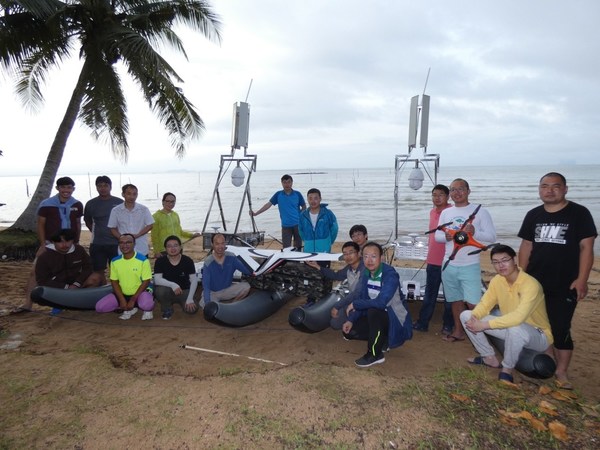BEIJING, Dec. 6, 2021 /PRNewswire/ -- The Irrawaddy dolphin Orcaella brevirostris is an endemic dolphin found in coastal waters in the South and Southeast Asia. Impacted by human activities, the population of Irrawaddy dolphin in the Songkhla Lake, Thailand is critically endangered and the species is considered vulnerable by the International Union for the Conservation of Nature (IUCN). In recent years, China and Thailand have deepened their cooperation in observation and research of endangered marine species, including Irrawaddy dolphins.
Thailand has attached great importance to the conservation of this Irrawaddy dolphin population in the Songkhla Lake and had accumulated experience for over ten years. However, the traditional observation methods that researchers used to apply, such as taking pictures from boats, were limited and inefficient. In 2011, China and Thailand reached consensus that modern technologies could be introduced to improve observing efficiency and promote scientific research.
What drew scientists from China and Thailand to the collaborative research is not only the endangered condition of Irrawaddy dolphins, but also their pivotal role in the marine ecosystem. Irrawaddy dolphins are at the top of marine food chain, which play a vital role in the healthy development of the marine ecosystem. Besides, Irrawaddy dolphins mean a great deal to local people in Thailand as well. They could help fishermen drive fish into nets in return for fishermen's feeding. They also provide valuable non-material benefits to people. Some temples in Thailand would even worship the skeletons and specimens of Irrawaddy dolphins.
"As such, protecting Irrawaddy dolphins has both ecological significance and social and cultural value," said Dr. Zhang Xuelei, head of the research team of marine endangered species from the First Institute of Oceanography, Ministry of Natural Resources, China.
Based on the application of unmanned aerial and sea surface vehicles, bio-acoustic technology and molecular biological techniques, researchers from China and Thailand have developed an integrated observation system, which can collect and transmit the data and images of the observed dolphins in real time.
These advanced technologies have been used in the observation and research of endangered marine species in Thailand. In May 2015, the research team made a breakthrough; with the aid of a DJI drone with camera, they successfully captured images of dugongs, also known as the legendary "mermaids", in the water north of Libong Island, Thailand, which confirmed the species' existence in this area for the first time and supported the establishment of conservation measures.

Scientists from China and Thailand were observing dugongs and dolphins at Libong Island. Photo provided by Dr. Zhang Xuelei
What impresses Dr. Zhang most is the experience of observing Irrawaddy dolphins with the application of this new observational mode in the Songkhla Lake, which validates its effectiveness. Due to the impact of past human activities, dolphins in this area are always sensitive to human existence, which makes it difficult to carry out scientific observation and acquire accurate information about the size of its population and the pattern of their activities.
To solve this problem, in May 2015, Dr. Zhang and his Thai colleagues performed a stereoscopic observation from the air, water surface and underwater in the Songkhla Lake, deploying an array of underwater bio-acoustic sensors and dispatching small sampans and man-piloted microplanes as well.
"We found that the time when dolphins appeared was exactly the time when we left and landed for lunch. We were surprised, yet realized how clever these sensitive animals were in response to 'strange' boat engines' sound," said Dr. Zhang. The research team then changed their schedule, stopped the engine and waited under the blazing sun on boats during lunch time. Sure enough, at noon, about 20 Irrawaddy dolphins came for their "safe lunch" assuming absence of strangers' interference. The team then collected data that they wanted long time ago.
"By learning more about the population, home range and other important behaviors of these Irrawaddy dolphins, we can develop better protection strategies, which would also benefit the biodiversity and stability of marine ecosystem," said Dr. Zhang.
Facing the challenges brought to in-situ collaboration of the international team from the COVID-19 pandemic, Dr. Zhang and his colleagues also attempt to conduct new observation methods. For example, by using satellite tags that can trace turtles and whales' movement, they hope to get more valuable information about their habitat use and migration patterns.
"We hope the new unmanned observation platform can free researchers from those laborious tasks that do not require intense human intelligence, so that they can give full play to their innovation and creativity on more meaningful work, making greater contribution to the protection of Irrawaddy dolphins and other endangered marine species," said Dr. Zhang Xuelei.